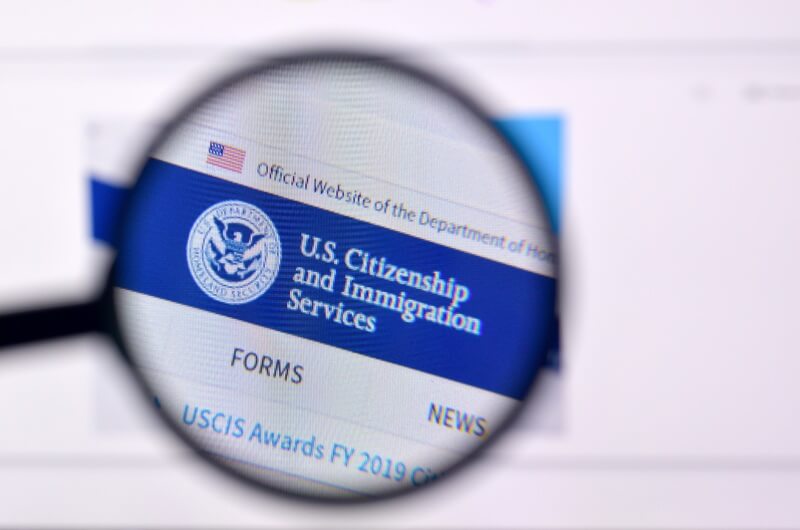What Would You Do After The USCIS Request For Evidence?
TL;DR:
If USCIS issues a Request for Evidence (RFE), it means more documentation is needed to decide your immigration case. Read the notice carefully, gather and organize the requested evidence, and submit your response by the deadline. Missing or ignoring an RFE can result in denial. Responding thoroughly, and sometimes with help from an immigration lawyer, can keep your case on track.
Receiving a letter from USCIS requesting more documents can feel stressful. But a Request for Evidence (RFE) is not a denial. It’s a second chance to strengthen your case and move forward.
Whether you applied for a green card, visa, work permit, or another immigration benefit, an RFE means something was missing or unclear. We’ll explain how to respond, what to include, and how to protect your case timeline.

What Is A USCIS RFE?
A Request for Evidence is an official notice from U.S. Citizenship & Immigration Services (USCIS) asking for more information to support your pending application or petition.
RFE means USCIS can’t yet approve your case and needs extra documents or clarification. It varies by case type, but they commonly address:
- Missing or unclear supporting documents.
- Gaps in financial proof or sponsor income.
- Incomplete or outdated medical exams.
- Concerns about eligibility, identity, or lawful entry.
- Inconsistencies in your submitted forms.
When USCIS sends an RFE, they are essentially allowing you to complete your file and fix any gaps before making a final decision.
Is An RFE Bad News?
Getting an RFE can be frustrating, but it’s not necessarily bad. It means USCIS sees potential in your case, but needs more to move forward. Think of it as a pause, not a stop.
An RFE is much better than a denial. It means your case is still alive and you have a real opportunity to respond, explain, and supplement your file. The key is to act quickly and carefully.
A complete, well-organized RFE response can result in swift approval. However, ignoring the notice or sending a weak response could lead to a denial or unnecessary delays.
How Long Do You Have To Respond?
USCIS gives you a specific timeframe to respond, usually between 30 and 87 days. It depends on the type of application and the complexity of the request. USCIS will state the deadline in the RFE letter. You must note:
- The countdown starts from the date the RFE was issued, not the date you receive it in the mail.
- There are no extensions allowed. Missing the deadline usually leads to denial.
- You must submit all requested evidence in one response.
If you wait too long to start gathering documents, you may find yourself racing the clock. It’s best to begin your response process immediately upon receiving the notice.
What Should You Do If You Receive An RFE?
A Request for Evidence (RFE) from USCIS is serious. How you respond can make or break your case, so move quickly and carefully.
Read The Notice Carefully
Start by reviewing the entire letter line by line. USCIS usually references specific sections of your application and explains exactly what’s missing or unclear. Pay attention to form numbers, dates, and any quoted regulations.
Knowing what USCIS wants is the foundation of a strong response. Don’t assume or guess; follow the instructions precisely.
Make A List Of What You Need
Once you understand the request, break it down into a checklist. For each item, note what documents are missing and what date range or version they require.
Know whether translations or official seals are necessary. It helps you stay organized and avoid overlooking something critical.
Organize Your Documents Clearly
USCIS officers review hundreds of files. Make your response easy to follow by numbering each page, grouping similar items, and using a table of contents if needed.
Avoid submitting loose pages or handwritten notes. Typed, legible, and clearly labeled documents create a stronger impression.
Write A Cover Letter (Optional But Helpful)
A summary letter is a great way to help the reviewing officer understand your response. It can list what you’re submitting and briefly explain anything unusual or substitute documentation.
A cover letter isn’t required, but it shows professionalism and makes your response easier to process.
Make Copies Of Everything
Before you send your packet, scan and save a digital copy. Also, keep a printed copy for your records. If something goes missing, you’ll have proof of what you submitted.
Mail It Correctly
Follow the instructions exactly:
- Send it to the address provided in the RFE letter.
- Use a reliable service with tracking (like USPS Priority, FedEx, or UPS).
- Include your USCIS receipt number on all pages.
Keep your mailing receipt as evidence that you responded on time.
What If You Can’t Get Everything In Time?
Some documents, like government records from another country or medical forms, may take longer than expected to receive.
If you’re running short on time, include proof that you requested the document. Then, write a short explanation about the delay. Submit alternative evidence if available (like affidavits or secondary records).
In some cases, USCIS may accept substitute evidence or issue a second RFE. But this is not guaranteed; doing your best to meet the original deadline is always the safest route.
What Happens After You Send It?
Once your RFE response is received, USCIS will resume processing your application. You may see a status update online like “Response to RFE Received.”
The officer may approve the case, issue another RFE, or deny the application. Processing times vary, but most applicants hear back within 60–90 days after submitting a complete RFE response.
If your case status remains unchanged after several months, it may be time to contact USCIS or consult an immigration lawyer for help following up.
What If You Miss The Deadline?
If USCIS does not receive your RFE response by the deadline, your application will likely be denied as “abandoned.” You may receive a notice stating the case is closed.
You’ll need to start over or file a motion to reopen (which is much harder). Exceptions are rare, so don’t count on extra time. Start gathering your documents early and send your response several days before the deadline.
How Can An Immigration Lawyer Help?
RFEs can be confusing and emotionally draining, especially when your status or future depends on the outcome. A skilled immigration lawyer can:
- Analyze the RFE and explain to you what the USCIS is asking.
- Help gather the right documents and organize your packet.
- Draft a compelling cover letter to clarify any weak spots.
- Avoid delays or denials due to technical mistakes.
Legal guidance is especially critical if your case involves complex issues like criminal history, prior visa overstays, or discrepancies in your record.
What Are Some Examples Of RFE Situations?

RFEs are common and vary depending on your immigration benefit type. Knowing the most frequent scenarios can help you prepare the right documents and avoid unnecessary delays or denials.
Employment-Based Green Card
RFE asked for proof that the sponsoring employer can pay the offered wage. Your strong response includes updated tax returns, recent payroll records, and a letter from the company’s finance department.
Marriage-Based Adjustment
RFE asked for evidence of a bona fide relationship. A strong response includes joint leases, wedding photos, insurance policies, utility bills, and affidavits from friends.
Asylum Application
RFE asked for clarification of inconsistencies in travel history. A strong response includes corrected statements, new supporting evidence, and an affidavit explaining the timeline.
Whether it’s missing proof of marriage or unclear financials, each RFE has a solution. Understanding common triggers helps you respond with confidence and strengthens your application moving forward.
Legal Terms To Remember
| Legal Term | Plain-English Definition |
| Request For Evidence (RFE) | A formal letter from USCIS asking for more information or documents before deciding on your case. |
| USCIS (U.S. Citizenship and Immigration Services) | The government agency that handles immigration applications and processes RFEs. |
| Form I-485 | The application to adjust status and become a green card holder or lawful permanent resident in the U.S. |
| Form I-130 | A petition filed by a U.S. citizen or a green card holder to sponsor a family member for a green card. |
| Receipt Notice | A confirmation sent by USCIS showing they received your application or response. |
| Supporting Evidence | Documents that help prove the information in your immigration application is true and complete. |
| Affidavit | A written, sworn statement used to support an application, often from friends or family. |
| Form I-797 | An official USCIS notice used for approvals, RFEs, or other communications. |
| Form AR-11 | A form used to report a change of address to USCIS. |
| Biometrics Appointment | A required appointment where USCIS collects your fingerprints, photo, and signature. |
| Motion to Reopen | A request to reopen a denied case, often due to new evidence or a missed response. |
| Form I-912 | An application for a fee waiver, based on low income or financial hardship. |
How To Answer An RFE Wisely?
If you receive an RFE, it means your case still has life. Don’t panic, but don’t delay, either. The time to act is now. Read the notice closely, stay organized, and respond completely.
If your case feels overwhelming or complex, get support. The right help can mean the difference between moving forward and starting over.
At Lincoln-Goldfinch Law, we know how stressful it is to deal with USCIS. If you’ve received an RFE or want to avoid one altogether, we’re here to help. Let’s build a strong, confident response, together.
Contact A U.S. Immigration Attorney Today!
Categories
How To Find Us
What Our Clients Say
“This Lawfirm is great, very professional and helpful. I love that they are always in communication and always available for when you have questions . 100% recommended by me and my family. Thank you Lincoln-Goldfinch Law – Abogados de Inmigración”





